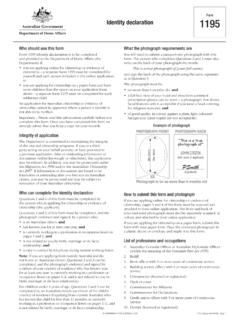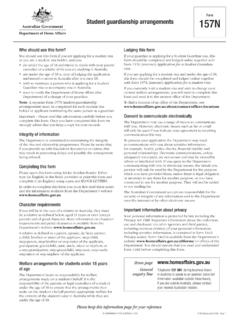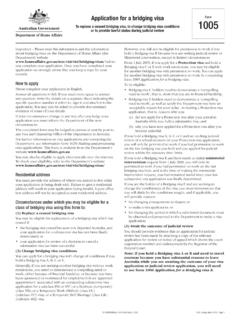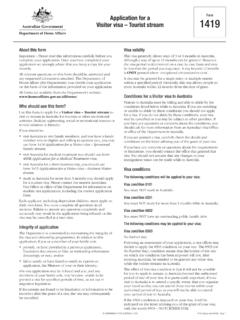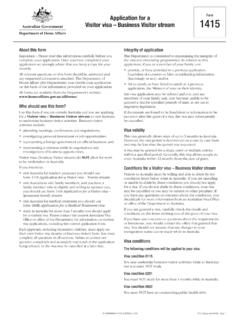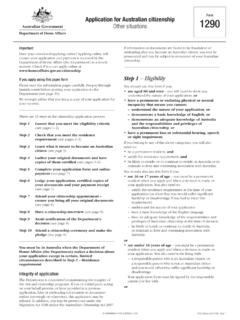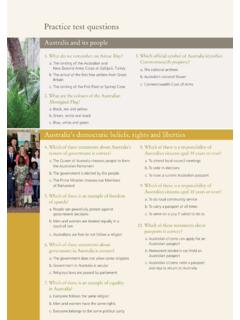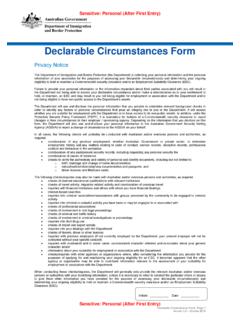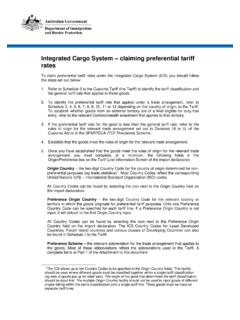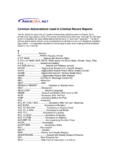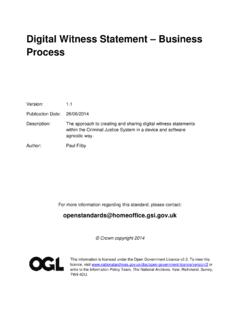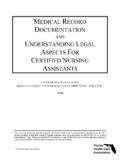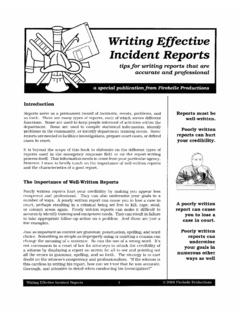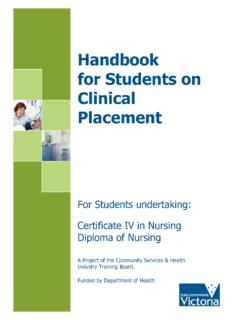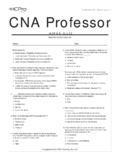Transcription of National Identity Proofing Guidelines - …
1 National . Identity . Proofing . Guidelines . National Identity Proofing Guidelines Identity SECURITY. ISBN: 978-1-925290-64-6 (print). ISBN: 978-1-925290-65-3 (online). Commonwealth of Australia 2016. All material presented in this publication is provided under a Creative Commons Attribution International licence ( ). For the avoidance of doubt, this means this licence only applies to material as set out in this document. The details of the relevant licence conditions are available on the Creative Commons website as is the full legal code for the CC BY licence ( ). Use of the Coat of Arms The terms under which the Coat of Arms can be used are detailed on the It's an Honour website ( ). Contact us Enquiries regarding the licence and any use of this document are welcome at: Attorney-General's Department 3 5 National Cct BARTON ACT 2600. Email: Contents Chapter 1 Introduction Background 1.
2 Purpose 1. Who should use these Guidelines ? 3. Scope 3. Conventions 4. Abbreviations and definitions 4. Implementation 5. Review of the Guidelines 5. Relationship to international standards 6. Chapter 2 Overview of Identity Proofing 7. What is Identity ? 7. Identity Proofing objectives 7. Levels of assurance 9. Chapter 3 Choice of Level of Assurance 12. Undertaking a risk assessment 12. Reliance on known customers 13. Choosing a level of assurance 13. Privacy 14. Other considerations 14. Chapter 4 Identity Proofing Objectives and Requirements at each Level of Assurance 15. Minimum Identity Proofing Requirements 15. National Identity Security Strategy i Chapter 5 People unable to meet minimum Identity Proofing requirements 19. Exceptions processes to confirm a claimed Identity 19. Verifying the Identity of children 20. Chapter 6 Assessing Applications 21. Recording Identity Proofing outcomes 21.
3 Identifying fraudulent applications 21. Chapter 7 Monitoring and Evaluation 23. Evaluation of Identity Proofing processes 23. Appendix A 24. Glossary 24. Appendix B 27. Suggested evidence types and weightings 27. Appendix C 30. Guidance on use of third party Identity service providers 30. ii National Identity Proofing Guidelines Chapter 1. Introduction Background Establishing confidence in a person's Identity is a critical starting point for delivering a range of government services and benefits, as it is for many transactions conducted by the private sector and other non-government organisations. Identity Proofing has traditionally been conducted in face to face' settings. Our increasingly digital economy, in which more and more people are looking to transact online at times most convenient to them, creates a range of challenges to these traditional approaches. However it also presents a range of potential opportunities through the use of new and emerging technologies.
4 Australians rely heavily on documents produced by a range of government agencies to help verify their identities. Rather than a single Identity card, the backbone of Australia's system of identities our Identity infrastructure is provided by around 20 government agencies that manage over 50 million core Identity documents. Australia's Identity infrastructure is also supported by many businesses and non-government organisations that issue documents or other services used as evidence of Identity , such as banks and universities. Identity crime is amongst the most prevalent of all types of crime in Australia. Each year around 4-5 per cent of Australians (estimated at around 750,000 to 937,000 people) experience Identity crime resulting in a financial loss. However the true extent of Identity crime is likely to be unknown, as a considerable proportion of incidents go Australian Crime Commission has rated Identity crime as a key enabler of serious and organised crime, which in turn costs Australia around $15 billion annually.
5 Identity Proofing is an important part of efforts to prevent Identity crime. It is also critical to promote the trust and confidence in identities, particularly online, which will be a key enabler of Australia's digital economy into the future. Purpose The purpose of these Guidelines is to strengthen Identity Proofing processes and increase trust through a standardised and transparent National approach. To fulfil this purpose, these Guidelines provide a set of recommended processes and requirements for Identity Proofing -the process by which organisations seek to verify a person's Identity by collecting information about the person and confirming it with relevant authoritative Identity Proofing is rarely done in absolute terms rather to a specified or understood level of assurance. The Guidelines replace the Identity Proofing elements of the 2007 Gold Standard Enrolment Framework (GSEF) developed under the National Identity Security Strategy.
6 The GSEF has been incorporated into requirements and processes for the highest level of assurance contained within these Guidelines . 1 Information would generally be collected directly from the individual concerned, but may be from another person who is authorised to act on their behalf, such as a legal guardian. National Identity Security Strategy 1. Identity Proofing is an integral part of the broader Identity assurance approach outlined in the National e-Authentication Framework (NeAF) and should be considered in the context of broader Identity authentication and management processes. The three phrases of an authentication process are: 1. Enrolment phase: application and initiation, Identity Proofing , record-keeping/recording and registration. 2. Credential management phase: all processes relevant to the lifecycle management, such as creation, issuance of a credential, binding of an individual to a credential, activation, storage, revocation, renewal and/or replacement and record keeping.
7 3. Entity authentication phase: consists of the entity's use of its credential to attest to its Identity to a relying party. Guidance on when to use these Guidelines as part of a broader Identity assurance approach is illustrated in Figure 1. Figure 1: Decision tree to inform appropriate use of these Guidelines Organisation assesses Refer to AS4860-2007: Identity risk and Knowledge-based determines Identity Identity authentication Recognizing Known Refer to the NeAF. Proofing processes as Customers and NeAF and other Guidelines part of broader Identity and standards under assurance processes the National Identity Security Strategy Organisation relies on a credential issued by another organisation to authenticate X's Identity (Reliance) Organisation Unknown customer (X) registers X (who is applies for a service now an assured Organisation Identity '). requests and verifies documents and information to confirm X's claimed Identity ( Identity Proofing ) Known customer (X) later returns to organisation USE THESE Guidelines .
8 Refer to the NeAF. 2 National Identity Proofing Guidelines Who should use these Guidelines ? These Guidelines are designed for use primarily by those Commonwealth and state and territory government agencies which issue documents and credentials that are most commonly used as evidence of a person's Identity ( Identity documents').2. The Guidelines may also be used by other government agencies which face Identity -related risks in the performance of their functions or delivery of services, if considered necessary following a risk assessment and cost benefit analysis. Identity related risks are those risks associated with incorrectly identifying a person. The consequences of incorrectly identifying a person may include: F. raud risks: a person without entitlement receiving a financial payment or other non-financial benefit as a result of a transaction ( payment of a benefit or grant).
9 S. ecurity risk: a person gaining unauthorised access to information, facilities, goods or services, particularly those of a sensitive nature P. rivacy risk: a person gaining unauthorised access to someone else's personal information D. ownstream risks: a person using an Identity credential or record issued or created by one organisation to commit Identity crime against other organisations. Private sector or other non-government organisations that face similar Identity related risks may also choose to use these Guidelines as a better practice reference. These Guidelines should be used by agencies or organisations looking to design new Identity Proofing processes or strengthen existing processes, as part of broader fraud, security, privacy and authentication and Identity management processes. Scope The Guidelines encourage greater transparency between the government agencies which form part of Australia's National Identity infrastructure.
10 They do this by providing a common framework for categorising and understanding various Identity Proofing processes. They also encourage reporting on implementation by key Identity document and credential issuing agencies to enable other organisations to better judge how much trust they should place in Identity Proofing processes of other organisations. These Guidelines are only suitable for the identification of people, not organisations or other types of entities. They are primarily designed for Identity Proofing at the point of initial enrolment3 with an organisation and do not address other, non- Identity related aspects of background checking ( criminal histories) or eligibility ( criteria such as income, residency or citizenship status). 2 Key Identity documents and credentials include those commonly requested as evidence of Identity , regardless of whether these documents and credentials were originally issued for Identity related purposes.
